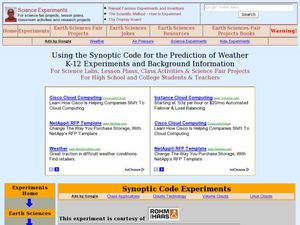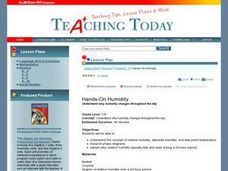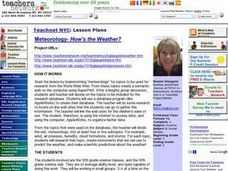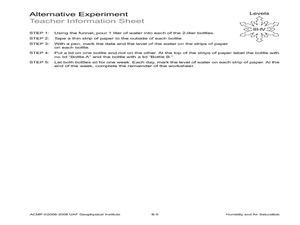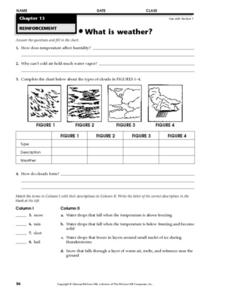Curated OER
My Weather Station
A printable weather station that will blow you away, this includes tools that little meteorologists can use to display their observations of daily weather conditions. There is a gauge where they can slide a pointer to show the...
Curated OER
Hot and Humid, That's Manu
Elementary and middle schoolers participate in a demonstration of the heat and humidity of the Manu rainforest environment. They watch and discuss a video, calculate the humidity and temperature in the humidified tent, and write a...
Curated OER
Understanding Weather
A succinct set of slides covers the main points for your weather unit. From the factors that contribute to conditions, to fronts and extreme occurrences, to the different types of clouds, numerous facts are listed in bullets. The only...
Curated OER
Water in the Atmosphere
A slide show serves as the backdrop for a instructional activity on the moisture in Earth's atmosphere. Through it, mini meteorologists learn about the attributes of the atmosphere and actually use data-collecting weather tools to make...
Institute of Electrical and Electronics Engineers
Making Sense of Sensors
Have small groups in your class construct working hygrometers as an example of the benefits of using sensors in engineering. This activity can be used during a weather unit when covering humidity or in a STEM activity as a preparation...
Curated OER
Regents High School Examination: Physical Setting Earth Science 2006
Test your class on earth science with this extensive resource. This test, created by The University of the State of New York Regents, is made up of 50 multiple choice questions and 32 short answer questions that cover the branches of...
Curated OER
Weather Patterns
Students research to determine weather patterns and natural hazards most likely to affect their region.
Curated OER
Using the Synoptic Code for the Prediction of Water
Students construct a thermoscreen for the experiment. In this earth science instructional activity, students make observations and interpret them using synoptic codes. They predict the weather based on gathered information.
Curated OER
Building a Psychrometer
Students create psychrometers to measure the humidity of the air. In this meteorology lesson, students make a wet-bulb thermomter and place it next to a dry-bulb thermometer to measure the relative humidity in the room.
Curated OER
Adopt a City-Winter Weather
In weather worksheet, students use an on line site to collect weather data. They create 10 different weather scenarios using a temperature and humidity slider. They includethe temperature, relative humidity and weather conditions and...
Curated OER
Daily Weather Log
In this weather worksheet, students keep a log of the temperature, precipitation, air pressure, humidity and wind for a fourteen day period. They record each of these measurements twice a day.
Curated OER
Deadly Deserts
In this reading comprehension worksheet, students read a passage regarding different deserts and answer 10 questions. The questions are a mix of true/false, short answer, and matching.
Curated OER
Hands-On Humidity
Students examine why humidity changes throughout the day. They study the concept of relative humidity, absolute humidity, and dew point temperature. They interpret phase diagrams and explain why relative humidity typically falls and...
Curated OER
Science: How's the Weather?
Fifth graders brainstorm meteorological terms to create a semantic web using SuperPrint. For each topic, they create instruments, such as barometers or psychomotors, that they use to make scientific predictions about the weather. After...
Curated OER
Rain Forest Adventures
Students identify and describe where tropical rain forests are located and examine the geographical correlation between rainfall and rain forest. They brainstorm what they think they know about tropical rain forests - where they're...
Curated OER
Dripping Wet or Dry as a Bone?
Students use a sponge and water model to explore the concept of relative humidity and create a percent scale. They define humidity and saturation, build a simple humidity/saturation model, collect, predict and interpret data, and create...
Curated OER
Good News - We're on the Rise!
Students build and observe a simple aneroid barometer to discover changes in barometric pressure and weather forecasting. They graph changes in barometric pressure for two weeks and make weather predictions.
Curated OER
Cloudy with a Chance of........
Fourth graders watch a video about Utah's weather and illustrate the water cycle. They read "Cloudy with a Chance of Meatballs" and identify weather words after listening to the weather radio. They create weather measurement instruments...
Curated OER
Differences between Climate and Weather
Students collect weather data over weeks, graph temperature data and compare the temperature data collected with averaged climate data where they live.
Curated OER
Condensation
Introduce middle school science learners to condensation with this presentation. It begins with a brief explanation of the process and humidity, but does not present all of the details. Three demonstrations need to be set up ahead of...
Curated OER
Humidity and Air Saturation
Young scholars experiment with air saturation. In this earth science lesson, students first complete an activity which teaches humidity. Then they use the scientific method to create their own experiments to test how long it takes a...
Curated OER
Relative Humidity
In this humidity worksheet, students use a graph showing hourly surface temperatures, dew points, and relative humidity to complete 10 fill in the blank questions.
Curated OER
Weather
In this weather learning exercise, students review what causes different weather patterns including the more severe weather patterns like tornadoes and hurricanes. Students also calculate relative humidity by using dry and wet bulb...
Curated OER
What is Weather II?
In this weather worksheet, students explain how temperature affects the humidity in weather. Then they complete a chart about the different types of clouds seen in the sky. Students also describe how clouds form and why.









